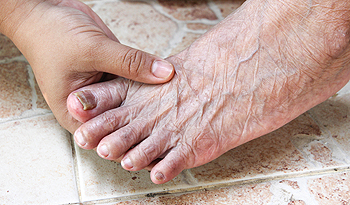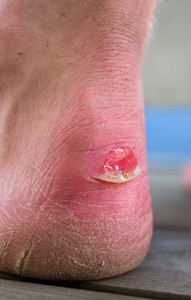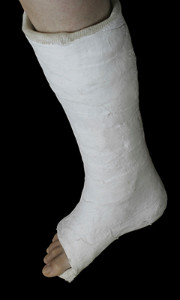Blog
Items filtered by date: February 2018
Symptoms of a Toenail Fungus
 White or yellow toenails is often indicative of a toenail fungus. Severe fungal infections can cause thickening of the nail, and even cause it to crumble and fall off the toe. If the feet are prone to excessive sweating, the chances may be increased for developing a toenail fungus. Additionally, this condition is contagious, and is often spread by walking barefoot in public places such as on shower floors and around community pools. Treatment remedies that may aid in helping the foot to feel better may include using a foot powder designed to eliminate moisture. Choosing to change socks often and keeping the toenails dry and trimmed will help the toes to feel better. A consultation with a podiatrist is recommended for treatment options.
White or yellow toenails is often indicative of a toenail fungus. Severe fungal infections can cause thickening of the nail, and even cause it to crumble and fall off the toe. If the feet are prone to excessive sweating, the chances may be increased for developing a toenail fungus. Additionally, this condition is contagious, and is often spread by walking barefoot in public places such as on shower floors and around community pools. Treatment remedies that may aid in helping the foot to feel better may include using a foot powder designed to eliminate moisture. Choosing to change socks often and keeping the toenails dry and trimmed will help the toes to feel better. A consultation with a podiatrist is recommended for treatment options.
For more information about treatment, contact Dr. Rosa Roman of Ankle and Foot Center. Our doctor can provide the care you need to keep you pain-free and on your feet.
Toenail Fungus Treatment
Toenail fungus is a condition that affects many people and can be especially hard to get rid of. Fortunately, there are several methods to go about treating and avoiding it.
Antifungals & Deterrence
Oral antifungal medicine has been shown to be effective in many cases. It is important to consult with a podiatrist to determine the proper regiment for you, or potentially explore other options.
Applying foot powder on the feet and shoes helps keep the feet free of moisture and sweat.
Sandals or open toed shoes – Wearing these will allow air movement and help keep feet dry. They also expose your feet to light, which fungus cannot tolerate. Socks with moisture wicking material also help as well.
If you have any questions please feel free to contact our office located in Bloomfield, NJ . We offer the newest diagnostic tools and technology to treat your foot and ankle needs.
Read more about Toenail FungusWhat is Sesamoiditis?
 The tendons attached to the bones located on the sole of the foot are referred to as the sesamoid bones. If these tendons become inflamed, typically resulting from an injury, a condition known as sesamoiditis occurs. A common symptom is pain experienced under the ball of the foot while walking, or discomfort may be felt from standing on your toes because the tendons are stretched. Choosing to wear high heels in addition to participating in sports that involve running and jumping may be common causes of this condition. Treatment may include ceasing the activity that caused sesamoiditis and considering a consultation with a podiatrist for custom-made insoles to provide relief.
The tendons attached to the bones located on the sole of the foot are referred to as the sesamoid bones. If these tendons become inflamed, typically resulting from an injury, a condition known as sesamoiditis occurs. A common symptom is pain experienced under the ball of the foot while walking, or discomfort may be felt from standing on your toes because the tendons are stretched. Choosing to wear high heels in addition to participating in sports that involve running and jumping may be common causes of this condition. Treatment may include ceasing the activity that caused sesamoiditis and considering a consultation with a podiatrist for custom-made insoles to provide relief.
Sesamoiditis is an unpleasant foot condition characterized by pain in the balls of the feet. If you think you’re struggling with sesamoiditis, contact Dr. Rosa Roman of Ankle and Foot Center. Our doctor will treat your condition thoroughly and effectively.
Sesamoiditis
Sesamoiditis is a condition of the foot that affects the ball of the foot. It is more common in younger people than it is in older people. It can also occur with people who have begun a new exercise program, since their bodies are adjusting to the new physical regimen. Pain may also be caused by the inflammation of tendons surrounding the bones. It is important to seek treatment in its early stages because if you ignore the pain, this condition can lead to more serious problems such as severe irritation and bone fractures.
Causes of Sesamoiditis
- Sudden increase in activity
- Increase in physically strenuous movement without a proper warm up or build up
- Foot structure: those who have smaller, bonier feet or those with a high arch may be more susceptible
Treatment for sesamoiditis is non-invasive and simple. Doctors may recommend a strict rest period where the patient forgoes most physical activity. This will help give the patient time to heal their feet through limited activity. For serious cases, it is best to speak with your doctor to determine a treatment option that will help your specific needs.
If you have any questions please feel free to contact our office located in Bloomfield, NJ . We offer the newest diagnostic and treatment technologies for all your foot and ankle needs.
Read more about SesamoiditisHow to Prevent Blisters From Developing
 A common condition that many runners endure are blisters on the feet. Blisters often cause discomfort and may force the ceasing of the activity that caused them to develop. If you choose to wear cotton socks while running, they will most likely absorb the sweat the feet produce, and friction will occur to develop a blister. Wearing socks that are synthetic may eliminate the sweat and may be a better option to choose, helping to stop blisters from developing.
A common condition that many runners endure are blisters on the feet. Blisters often cause discomfort and may force the ceasing of the activity that caused them to develop. If you choose to wear cotton socks while running, they will most likely absorb the sweat the feet produce, and friction will occur to develop a blister. Wearing socks that are synthetic may eliminate the sweat and may be a better option to choose, helping to stop blisters from developing.
Blisters are prone to making everyday activities extremely uncomfortable. If your feet are hurting, contact Dr. Rosa Roman of Ankle and Foot Center. Our doctor can provide the care you need to keep you pain-free and on your feet.
Foot Blisters
Foot blisters develop as a result of constantly wearing tight or ill-fitting footwear. This happens due to the constant rubbing from the shoe, which can often lead to pain.
What Are Foot Blisters?
A foot blister is a small fluid-filled pocket that forms on the upper-most layer of the skin. Blisters are filled with clear fluid and can lead to blood drainage or pus if the area becomes infected.
How Do Blisters Form?
Blisters on the feet are often the result of constant friction of skin and material, usually by shoe rubbing. Walking in sandals, boots, or shoes that don’t fit properly for long periods of time can result in a blister. Having consistent foot moisture and humidity can easily lead to blister formation.
Prevention & Treatment
It is important to properly care for the affected area in order to prevent infection and ease the pain. Do not lance the blister and use a Band-Aid to provide pain relief. Also, be sure to keep your feet dry and wear proper fitting shoes. If you see blood or pus in a blister, seek assistance from a podiatrist.
If you have any questions, please feel free to contact our office located in Bloomfield, NJ . We offer the newest diagnostic and treatment technologies for all your foot care needs.
Read more about Blisters on the FeetHow A Broken Ankle is Treated
 If you have fallen and are experiencing severe pain, swelling, or difficulty in moving your foot, you may have a broken ankle. It may be challenging to differentiate between a break and a sprain; therefore, an X-ray is often taken for a proper diagnosis. Keeping the leg elevated will help with the swelling that occurs, and limiting weight on the affected ankle will aid in alleviating the discomfort associated with this painful injury. If a minor fracture is incurred, wearing a supportive boot or splint may be recommended, as well as using crutches to keep the weight off the ankle. For a more serious fracture, surgery may be suggested to realign the bones, and a cast will be fitted to promote proper healing. It generally takes 6-12 weeks for improvement to occur, but this time frame will vary from patient to patient. If you suspect that your ankle may be broken or sprained, see a podiatrist immediately.
If you have fallen and are experiencing severe pain, swelling, or difficulty in moving your foot, you may have a broken ankle. It may be challenging to differentiate between a break and a sprain; therefore, an X-ray is often taken for a proper diagnosis. Keeping the leg elevated will help with the swelling that occurs, and limiting weight on the affected ankle will aid in alleviating the discomfort associated with this painful injury. If a minor fracture is incurred, wearing a supportive boot or splint may be recommended, as well as using crutches to keep the weight off the ankle. For a more serious fracture, surgery may be suggested to realign the bones, and a cast will be fitted to promote proper healing. It generally takes 6-12 weeks for improvement to occur, but this time frame will vary from patient to patient. If you suspect that your ankle may be broken or sprained, see a podiatrist immediately.
Broken ankles need immediate treatment. If you are seeking treatment, contact Dr. Rosa Roman from Ankle and Foot Center. Our doctor can provide the care you need to keep you pain-free and on your feet.
Broken Ankles
A broken ankle is experienced when a person fractures their tibia or fibula in the lower leg and ankle area. Both of these bones are attached at the bottom of the leg and combine to form what we know to be our ankle.
When a physician is referring to a break of the ankle, he or she is usually referring to a break in the area where the tibia and fibula are joined to create our ankle joint. Ankles are more prone to fractures because the ankle is an area that suffers a lot of pressure and stress. There are some obvious signs when a person experiences a fractured ankle, and the following symptoms may be present.
Symptoms of a Fractured Ankle
- Excessive pain when the area is touched or when any pressure is placed on the ankle
- Swelling around the area
- Bruising of the area
- Area appears to be deformed
If you suspect an ankle fracture, it is recommended to seek treatment as soon as possible. The sooner you have your podiatrist diagnose the fracture, the quicker you’ll be on the way towards recovery.
If you have any questions, please feel free to contact our office located in Bloomfield, NJ . We offer the newest diagnostic and treatment technologies for all your foot care needs.
Blog Archives
- April 2025
- March 2025
- February 2025
- January 2025
- December 2024
- November 2024
- October 2024
- September 2024
- August 2024
- July 2024
- June 2024
- May 2024
- April 2024
- March 2024
- February 2024
- January 2024
- December 2023
- November 2023
- October 2023
- September 2023
- August 2023
- July 2023
- June 2023
- May 2023
- April 2023
- March 2023
- February 2023
- January 2023
- December 2022
- November 2022
- October 2022
- September 2022
- August 2022
- July 2022
- June 2022
- May 2022
- April 2022
- March 2022
- February 2022
- January 2022
- December 2021
- November 2021
- October 2021
- September 2021
- August 2021
- July 2021
- June 2021
- May 2021
- April 2021
- March 2021
- February 2021
- January 2021
- December 2020
- November 2020
- October 2020
- September 2020
- August 2020
- July 2020
- June 2020
- May 2020
- April 2020
- March 2020
- February 2020
- January 2020
- December 2019
- November 2019
- October 2019
- September 2019
- August 2019
- July 2019
- June 2019
- May 2019
- April 2019
- March 2019
- February 2019
- January 2019
- December 2018
- November 2018
- October 2018
- September 2018
- August 2018
- July 2018
- June 2018
- May 2018
- April 2018
- March 2018
- February 2018
- January 2018
- December 2017
- November 2017
- October 2017
- September 2017
- August 2017
- July 2017
- June 2017
- May 2017
- April 2017
- March 2017
- February 2017
- January 2017
- December 2016
- November 2016
- October 2016
- September 2016
- August 2016
- July 2016
- June 2016
- May 2016
- April 2016
